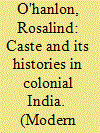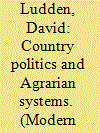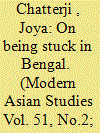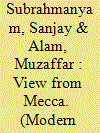|
|
|
Sort Order |
|
|
|
Items / Page
|
|
|
|
|
|
|
| Srl | Item |
| 1 |
ID:
152622


|
|
|
|
|
| Summary/Abstract |
David Washbrook's influential early work on South India set the terms for much subsequent debate about caste, with its exploration of the key role of the colonial state in shaping caste ideologies and institutions. Over subsequent decades, historians and anthropologists have come increasingly to emphasise the ‘colonial construction’ of caste and its enduring legacies in post-colonial India. Yet there were also significant continuities linking the forms of colonial caste with much earlier regional histories of conflict and debate, whose legacies can be traced into the late colonial period. In particular, the juxtaposition between Brahman and non-Brahman itself was anticipated in a tradition of conservative social commentary that emerged in the Deccan Sultanate state of Ahmadnagar, and came to circulate widely through Banaras and western India during the seventeenth and eighteenth centuries. This tradition of commentary acquired new salience during the nineteenth century. It entered the colonial archive as an authoritative source of knowledge, and also provoked early ‘non-Brahman’ intellectuals into a fresh engagement with its conservative social vision. In their attempts to rebut this vision, these intellectuals displayed a detailed knowledge of its social history and a deep familiarity with the judicial decisions through which it had been upheld in earlier centuries.
|
|
|
|
|
|
|
|
|
|
|
|
|
|
|
|
| 2 |
ID:
152617


|
|
|
|
|
| Summary/Abstract |
The forceful expropriation of land, labour, water, and other productive resources is fundamental for processes of agricultural expansion and intensification. What is known today as ‘land grab’ was theorized by Marx as ‘primitive accumulation’ and by David Harvey as ‘accumulation by dispossession’. Today it is most prominent and controversial in Africa, where the governments of India and China are major perpetrators; and it also drives most contemporary urban expansion in India and China. This article deploys David Washbrook's idea of ‘country politics’ to explore the process of land grabbing in the early-modern expansion of agrarian Bengal, where local peasant society and worldwide imperial political economy came together to expand frontiers of farming in what is now the Sylhet District of Bangladesh.
|
|
|
|
|
|
|
|
|
|
|
|
|
|
|
|
| 3 |
ID:
152614


|
|
|
|
|
| Summary/Abstract |
Early modern Siam is usually portrayed as a predominantly rural, peasant society. This picture is assumed from the worldwide trend of rural-to-urban transition, rather than from study of Siam itself. The available sources have a striking lack of any evidence on rural society. This article explores the possibility that this absence may reflect a real-world difference, not just perception. Unlike in temperate zones, enough food could be produced without dedicating the efforts of a majority of the population to agriculture. Rice could be grown by part-time ‘commuter’ agriculture, and other foods found by everyday hunting and gathering. Cultural preference based on the instinct for survival may have reinforced an affinity for urban residence. The scant data on Siam's demography suggest the majority of the population lived in urban places. Descriptions of the capital portray a commercial and industrial centre, capable of employing many in non-agricultural pursuits. The state systems for raising resources were tailored to an urban rather than a rural society. While the scarcity of data on early Siam makes any ‘proof’ impossible, the thesis that Siam was a predominantly urban society is worth exploring. From the early eighteenth century on, Siam was subject to a process of ‘ruralization’ that created the familiar peasant society that historians have projected back into the past.
|
|
|
|
|
|
|
|
|
|
|
|
|
|
|
|
| 4 |
ID:
152621


|
|
|
|
|
| Summary/Abstract |
This article traces the way in which modern institutions emerged in one region of British-ruled India—the Godavari Delta of coastal Andhra—during the early nineteenth century. Rejecting recently popular cultural theories and the vague language of ‘multiple modernities’, it suggests that modernity can be defined as the practical effort to govern subjects perceived as strangers with abstract and general categories. But, arguing that our conception of modernity needs to be limited, the article suggests that modern institutions always rely on non-modern ways of life: the rule of law depends on ideas about individual honour; bureaucracy; on family connections and affective expressions of loyalty; and rational interests that are coordinated by archaic idioms of political leadership. The peculiarity of the history of modernity in imperial India was marked not by the limited or partial imposition of modern practices, but by the British regime's reluctance to accept the legitimacy of the very non-modern forms of power it relied on. Tracing this process in the Godavari Delta, the article shows how a regime with limited local resources asserted the monopolistic authority of its structures of government, but in doing so, corroded its own capacity to exercise power. Local institutions which had coordinated local productive resources were undermined, but alternative forms of local leadership were unable to emerge. The consequence was famine in the 1830s, and in the 1840s an effort to refound the imperial regime by imposing British power on the region's natural resources.
|
|
|
|
|
|
|
|
|
|
|
|
|
|
|
|
| 5 |
ID:
152620


|
|
|
|
|
| Summary/Abstract |
Taking as its point of departure David Washbrook's essay ‘The Indian Economy and the British Empire’, this article takes a more detailed look at some episodes in the history of British India in the era of the Company Raj, with a view to placing them within a broader imperial framework, as advocated by Washbrook. The first part of the article examines, through an array of case studies, the actual contribution made by the Company to ‘global’ British expansion, concluding that it invested a lot of (Indian) blood and money in ventures from which it derived little benefit, as in the case of the expeditions to Manila (1762), Ceylon (1795), and Java (1811). It is shown that the Company's interests were ultimately sacrificed to the necessity of maintaining the European balance of power through consideration of the colonial interests of minor European powers such as Portugal or the Netherlands. While the Company saw its interests thus overlooked in the ‘global’ imperial arena, it could not find compensation in increased economic activity in India itself. Although the compulsions of ‘military-fiscalism’ largely explain such an outcome, we should not lose sight of the role of Indian agency in limiting the Company's options, as is shown by a rapid look at the history of both labour and capital markets, which the Company did not succeed in bending completely to its needs.
|
|
|
|
|
|
|
|
|
|
|
|
|
|
|
|
| 6 |
ID:
152613


|
|
|
|
|
| Summary/Abstract |
Most of the articles in this special issue were presented at a conference held at Trinity College, Cambridge, in May 2014 in honour of David Washbrook, to mark his 65th birthday. As a Festschrift, it is unusual: its authors are drawn not only from the ranks of Washbrook's students, but also include his collaborators and colleagues. But it is, we hope, more than a commemorative volume. Inspired by David Washbrook's work, the articles not only speak to the rich range of topics he has taken up in his distinguished career, they also reflect important new directions in the economic and social history of India, and Asia more broadly.
|
|
|
|
|
|
|
|
|
|
|
|
|
|
|
|
| 7 |
ID:
152618


|
|
|
|
|
| Summary/Abstract |
By examining the career of a woman agrarian entrepreneur in early nineteenth-century Gujarat, this article seeks to foreground the role of family firms specializing in the assessment, realization, and investment of land revenue. The article argues that such firms, which were commonly found service providers in the eighteenth and early nineteenth centuries, were deemed to be alienators of the loyalties and revenues that the East India Company state considered its due. They were allowed to persist on sufferance for a few decades but were phased out by the 1830s, an obliteration that has erased their role from the history of South Asian capitalism.
|
|
|
|
|
|
|
|
|
|
|
|
|
|
|
|
| 8 |
ID:
152626


|
|
|
|
|
| Summary/Abstract |
Immobility raises awkward questions for theorists of migration. From their standpoint, migration is unusual behaviour that requires explanation. Its obverse—staying in place—is seen as an ‘obvious’ state of affairs that calls for no explanation. Yet assumptions about the ordinariness of immobility are insecure. For one thing, we know a great deal more about the mobile societies of early modern Asia; for another, Asian mobility in the era of high imperialism is much better understood. Yet despite these cumulative gains in our understanding of the scale of mobility in early-modern and modern Asia, and its acceleration in ‘the age of migration’, immobility continues to be seen as the ‘obvious’ state of affairs. This article suggests some preliminary answers to ‘the immobility paradox’, based on a study of the greater Bengal region. By analysing the impact of the intensifying links, in the late colonial era, between Bengal and the global economy, it shows that this varied widely for different people, in ways that had a profound bearing on their capacity to move. The article develops the notion of ‘deficits’ which worked to inhibit the mobility of particular groups and individuals. Physical frailty and obligations of care, it shows, were crucial factors in shaping immobility. Relations of gender and generation, and the inequalities embedded in these relations, produced ‘overabundances’—of obligations to people and places—that tied certain people down. Finally, it hints at the reasons why, and the ways in which, stayers-on have grown poorer.
|
|
|
|
|
|
|
|
|
|
|
|
|
|
|
|
| 9 |
ID:
152623


|
|
|
|
|
| Summary/Abstract |
The sirdar (also termed sardar and jobber in Indian historiography)—foreman, recruiter, at once a labour leader and an important intermediary figure for the employers of labour both in India and in the sugar colonies—is reassessed in this article. Tithankar Roy's thoughtful 2007 article looked at how the sirdars’ multiple roles represent an incorporation of traditional authority in a modern setting, giving rise to certain contradictions. In 2010 Samita Sen, conversely, developed Rajnarayan Chandavarkar's argument about the use of labour intermediaries in colonial India to reveal how, in the case of the Assam tea plantations, the nexus between contractors and sirdars belies the ‘benign’ role often accorded to the intermediary within narratives from the tea industry. This article provides examples from the overseas labour destinations in the Indian Ocean region, particularly Mauritius, to further develop and nuance the debate, through an assessment of the complexity of sirdari roles in the colonial Indian labour diaspora.
|
|
|
|
|
|
|
|
|
|
|
|
|
|
|
|
| 10 |
ID:
152615


|
|
|
|
|
| Summary/Abstract |
This article examines the history of Gujarat-Red Sea relations in the first quarter of a century after the Ottoman conquest of the Hijaz, in the light of Arabic narrative sources that have hitherto been largely neglected. While earlier historians have made use of both Ottoman and Portuguese archives in this context, we return here to the chronicles of Mecca itself, which prove to be an unexpectedly interesting and rich source on the matter. Our main interest is in the figure of Jarullah ibn Fahd and his extensive annalistic work, Nayl al-munā. A good part of our analysis will focus on the events of the 1530s, and the dealings of Sultan Bahadur Shah Gujarati's delegation to the Ottomans, headed by ‘Abd al-‘Aziz Asaf Khan. But we shall also look at the longer history of contacts, and conclude with brief remarks on the relevance of the career of the celebrated Gujarati-Hijazi intellectual, Qutb al-Din Muhammad Nahrawali. We thus hope to add another important, concrete dimension to our understanding of India's location in the early modern Indian Ocean world, as a tribute to the career and contribution of David Washbrook, our friend and colleague.
|
|
|
|
|
|
|
|
|
|
|
|
|
|
|
|
| 11 |
ID:
152625


|
|
|
|
|
| Summary/Abstract |
With a focus by scholars on states and classes, the environment of India and its impact on agriculture has been neglected, except to provide a context—which was largely unchanging—in which states extracted and classes struggled. One example of environment as the backdrop is the distinction between ‘wet’ and ‘dry’ areas in Tamilnad and South India more widely. This distinction is based on the availability of water and on the local categorization of agricultural activity (nanjai versus punjai). There are two problems with this approach, however. First, it is a narrow treatment of the environment as it neglects other features of the land such as forests, grasslands, scrublands, and other so-called wasteland. Second, it sees the environment as a fixed entity, but the landscape has changed dramatically in the past, especially in the nineteenth and twentieth centuries. If changes in the environment are included in the mix, the development of agriculture in nineteenth-century Tamilnad may be seen in some new ways. Agricultural production existed in symbiosis with the complex and varied environment of the region. In the early nineteenth century Tamilnad contained extensive tracts of forests, widespread wastelands, and abundant surface water. This diverse environment made it possible to maintain high levels of agricultural productivity as it provided the resources to maintain the fertility of the soil and the supplies of water that were critical for agricultural enterprise, as well as the well-being of the rural population. The consequences of changing regimes of water is the focus of this article.
|
|
|
|
|
|
|
|
|
|
|
|
|
|
|
|
|
|
|
|
|